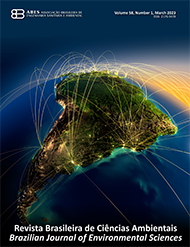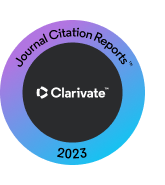Sunflower seed husks as a cost-effective adsorbent for chloroquine removal from water
DOI:
https://doi.org/10.5327/Z2176-94781907Keywords:
agroindustrial residue; water pollution; bioadsorption; emerging contaminants; advanced water treatment.Abstract
The increased production and consumption of pharmaceuticals represent a potential environmental threat. Thus, advanced treatments are necessary to remove pharmaceutical products from water. A promising removal alternative is low-cost adsorbents, due to their availability, low processing, and favorable results. This study used sunflower seed husks (SSH) and chemically treated sunflower seed husks (TSSH) as bioadsorbents to remove chloroquine from water. Results showed that the pseudo-second-order is the kinetic model with the best fit for both adsorbents. As for isothermic models, the best fit for SSH was Langmuir, and for TSSH, Freundlich. Maximum adsorption capacities of qe=168.09±22.98 mg/g and qe=185.91±27.23 mg/g were found through the isothermic models for SSH and TSSH, respectively. In addition, SSH reached 80% of its initial adsorption capacity after three adsorption-desorption cycles, indicating physisorption and good applicability due to its reusability. Thus, SSH is an efficient adsorbent for chloroquine removal with excellent regeneration capacity, low production cost, and low waste production. This study serves as a model for the use of SSH in the removal of contaminants of emerging concern.
Downloads
References
Ahmad, Z.; Paleologou, M.; Xu, C.C., 2021. Oxidative depolymerization of lignin using nitric acid under ambient conditions. Industrial Crops and Products, v. 170, 113757. https://doi.org/10.1016/j.indcrop.2021.113757
Alhares, H.S.; Shaban, M.A.A.; Salman, M.S.; M-Ridha, M.J.; Mohammed, S.J.; Abed, K.M.; Ibrahim, M.A.; Al-Banaa, A.K.; Hasan, H.A., 2023. Sunflower husks coated with copper oxide nanoparticles for reactive blue 49 and reactive red 195 removals: adsorption mechanisms, thermodynamic, kinetic, and isotherm studies. Water, Air, & Soil Pollution, v. 234, (1), 35. https://doi.org/10.1007/s11270-022-06033-6
Araujo, L.A.; Bezerra, C.O.; Cusioli, L.F.; Rodríguez, M.T.; Gomes, R.G.; Bergamasco, R., 2021. Diclofenac adsorption using a low-cost adsorbent derived from Guazuma ulmifolia Lam. fruit via chemical and thermal treatment. Journal of Environmental Chemical Engineering, v. 9, (6), 106629. https://doi.org/10.1016/j.jece.2021.106629
Araujo, C.M.B.; Wernke, G.; Ghislandi, M.G.; Diório, A.; Vieira, M.F.; Bergamasco, R.; Sobrinho, M.A.M.; Rodrigues, A.E., 2023. Continuous removal of pharmaceutical drug chloroquine and safranin-o dye from water using agar-graphene oxide hydrogel: selective adsorption in batch and fixed-bed experiments. Environmental Research, v. 216, 114425. https://doi.org/10.1016/j.envres.2022.114425
Bankole, D.T.; Oluyori, A.P.; Inyinbor, A.A., 2022. Acid-activated Hibiscus sabdariffa seed pods biochar for the adsorption of chloroquine phosphate: prediction of adsorption efficiency via machine learning approach. South African Journal of Chemical Engineering, v. 42, 162-175. https://doi.org/10.1016/j.sajce.2022.08.012
Cappelli, F.; Longoni, O.; Rigato, J.; Rusconi, M.; Sala, A.; Fochi, I.; Palumbo, M.T.; Polesello, S.; Roscioli, C.; Salerno, F.; Stefani, F.; Bettinetti, R.; Valsecchi, S., 2022. Suspect screening of wastewaters to trace anti-COVID-19 drugs: potential adverse effects on aquatic environment. Science of The Total Environment, v. 824, 153756. https://doi.org/10.1016/j.scitotenv.2022.153756
Cusioli, L.F.; Quesada, H.B.; Andrade, M.B.; Gomes, R.G.; Bergamasco, R., 2021. Application of a novel low-cost adsorbent functioned with iron oxide nanoparticles for the removal of triclosan present in contaminated water. Microporous and Mesoporous Materials, v. 325, 111328. https://doi.org/10.1016/j.micromeso.2021.111328
Cusioli, L.F.; Quesada, H.B.; Baptista, A.T.A.; Gomes, R.G.; Bergamasco, R., 2020. Soybean hulls as a low-cost biosorbent for removal of methylene blue contaminant. Environmental Progress & Sustainable Energy, v. 39, (2), e13328. https://doi.org/10.1002/ep.13328
Dabić, D.; Babić, S.; Škorić, I., 2019. The role of photodegradation in the environmental fate of hydroxychloroquine. Chemosphere, v. 230, 268-277. https://doi.org/10.1016/j.chemosphere.2019.05.032
Dada, A.O.; Inyinbor, A.A.; Bello, O.S.; Tokula, B.E., 2021. Novel plantain peel activated carbon–supported zinc oxide nanocomposites (PPAC-ZnO-NC) for adsorption of chloroquine synthetic pharmaceutical used for COVID-19 treatment. Biomass Conversion and Biorefinery, v. 13, 9181-9193. https://doi.org/10.1007/s13399-021-01828-9
Delgado, N.; Capparelli, A.; Navarro, A.; Marino, D., 2019. Pharmaceutical emerging pollutants removal from water using powdered activated carbon: study of kinetics and adsorption equilibrium. Journal of Environmental Management, v. 236, 301-308. https://doi.org/10.1016/j.jenvman.2019.01.116
Erto, A.; Giraldo, L.; Lancia, A.; Moreno-Piraján, J.C., 2013. A Comparison between a low-cost sorbent and an activated carbon for the adsorption of heavy metals from water. Water, Air, & Soil Pollution, v. 224, (4), 1531. https://doi.org/10.1007/s11270-013-1531-3
Freundlich, H.M., 1906. Over the adsorption in solution. The Journal of Physical Chemistry A, v. 57, 385-470.
Ho, Y.S;. McKay, G., 1999. Pseudo-second order model for sorption processes. Process Biochemistry, v. 34, (5), 451-465. https://doi.org/10.1016/S0032-9592(98)00112-5
Jaihan, W.; Mohdee, V.; Sanongraj, S.; Pancharoen, U.; Nootong, K., 2022. Biosorption of lead (II) from aqueous solution using cellulose-based bio-adsorbents prepared from unripe papaya (Carica papaya) peel waste: removal efficiency, thermodynamics, kinetics and isotherm analysis. Arabian Journal of Chemistry, v. 15, (7), 103883. https://doi.org/10.1016/j.arabjc.2022.103883
Januário, E.F.D.; Vidovix, T.B.; Bissaro, C.A.; Defendi, R.O.; Jorge, L.M.M.; Bergamasco, R.; Vieira, A.M.S., 2023. Evaluation of the black soybean hulls agro-industrial waste for chloroquine removal from aqueous medium and treatment of multi-components. Journal of Dispersion Science and Technology, v. 45, (5), 1-11. https://doi.org/10.1080/01932691.2023.2186426
Kocadagistan, B.; Kocadagistan, E., 2016. The effects of sunflower seed shell modifying process on textile dye adsorption: kinetic, thermodynamic and equilibrium study. Desalination and Water Treatment, v. 57, (7), 3168-3178. https://doi.org/10.1080/19443994.2014.980329
Lagergren, S.Y. 1898. About the theory of so-called adsorption of solid substance. Kungliga Svenska Vetenskapsakademiens Handlingar, v. 4, 1-39.
Langmuir, I., 1916. The constitution and fundamental properties of solids and liquids. Part I. Solids. The Journal of Physical Chemistry A, v. 38, (11), 2221-2295. https://doi.org/10.1021/ja02268a002
Mellah, A.; Fernandes, S.P.S.; Rodríguez, R.; Otero, J.; Paz, J.; Cruces, J.; Medina, D.D.; Djamila, H.; Espiña, B.; Salonen, L.M., 2018. Adsorption of pharmaceutical pollutants from water using covalent organic frameworks. Chemistry European Journal, v. 24, (42), 10601-10605. https://doi.org/10.1002/chem.201801649
Midassi, S.; Bedoui, A.; Bensalah, N., 2020. Efficient degradation of chloroquine drug by electro-fenton oxidation: effects of operating conditions and degradation mechanism. Chemosphere, v. 260, 127558. https://doi.org/10.1016/j.chemosphere.2020.127558
Nason, S.L.; Lin, E.; Eitzer, B.; Koelmel, J.; Peccia, J., 2022. Changes in sewage sludge chemical signatures during a covid-19 community lockdown, part 1: traffic, drugs, mental health, and disinfectants. Environmental Toxicology and Chemistry, v. 41, (5), 1179-1192. https://doi.org/10.1002/etc.5217
Nguyen, T.-B.; Nguyen, T.-K.-T.; Chen, W.-H.; Chen, C.-W.; Bui, X.-T.; Patel, A.K.; Dong, C.-D., 2023. Hydrothermal and pyrolytic conversion of sunflower seed husk into novel porous biochar for efficient Adsorption of Tetracycline. Bioresource Technology, v. 373, 128711. https://doi.org/10.1016/j.biortech.2023.128711
Nguyen, T.-K.-T.; Nguyen, T.-B.; Chen, W.-H.; Chen, C.-W.; Patel, A.K.; Bui, X.-T.; Chen, L.; Singhania, R.R.; Dong, C.-D., 2023. Phosphoric acid-activated biochar derived from sunflower seed husk: selective antibiotic adsorption behavior and mechanism. Bioresource Technology, v. 371, 128593. https://doi.org/10.1016/j.biortech.2023.128593
Nippes, R.; Picoli, P.D.; Macruz, G.N.S.; Scaliante, M.H.N.O., 2021. A critical review on environmental presence of pharmaceutical drugs tested for the COVID-19 treatment. Process Safety and Environmental Protection, v. 152, 568-582. https://doi.org/10.1016/j.psep.2021.06.040
Olaitan, O.J.; Anyakora, C.; Bamiro, T.; Tella, A.T. 2014. Determination of pharmaceutical compounds in surface and underground water by solid phase extraction-liquid chromatography. Journal of Environmental Chemistry and Ecotoxicology, v. 6, (3), 20-26. https://doi.org/10.5897/JECE2013.0312
OriginLab, 2018. Origini(Pro). [Version 2018]. OriginLab Corporation, Northampton.
Plantone, D.; Koudriavtseva, T., 2018. Current and future use of chloroquine and hydroxychloroquine in infectious, immune, neoplastic, and neurological diseases: a mini-review. Clinical Drug Investigation, v. 38, (8), 653-671. https://doi.org/10.1007/s40261-018-0656-y
Pradhan, B.K.; Sandle, N.K., 1999. Effect of different oxidizing agent treatments on the surface properties of activated carbons. Carbon, v. 37, (8), 1323-1332. https://doi.org/10.1016/S0008-6223(98)00328-5
Ramesh, M.; Anitha, S.; Poopal, R.K.; Shobana, C., 2018. Evaluation of acute and sublethal effects of chloroquine (C18H26CIN3) on certain enzymological and histopathological biomarker responses of a freshwater fish. Cyprinus Carpio Toxicology Reports, v. 5, 18-27. https://doi.org/10.1016/j.toxrep.2017.11.006
Rebolledo, U.A.; Rico-Martínez, R.; Fernández, R.; Páez-Osuna, F., 2022. Synergistic effect of chloroquine and copper to the euryhaline rotifer Proales similis. Ecotoxicology, v. 31, (6), 1035-1043. https://doi.org/10.1007/s10646-022-02570-2
Rojas, R.; Morillo, J.; Usero, J.; Vanderlinden, E.; El Bakouri, H., 2015. Adsorption study of low-cost and locally available organic substances and a soil to remove pesticides from aqueous solutions. Journal of Hydrology, v. 520, 461-472. https://doi.org/10.1016/j.jhydrol.2014.10.046
Sang, Y.; Chen, H.; Khalifeh, M.; Li, Y., 2023. Catalysis and chemistry of lignin depolymerization in alcohol solvents - a review. Catalysis Today, v. 408, 168-181. https://doi.org/10.1016/j.cattod.2022.06.005
Santos, R.K.S.; Nascimento, B.F.; Araújo, C.M.B.; Cavalcanti, J.V.F.L.; Bruckmann, F.S.; Rhoden, C.R.B.; Dotto, G.L.; Oliveira, M.L.S.; Silva, L.F.O.; Sobrinho, M.A.M., 2023. Removal of chloroquine from the aqueous solution by adsorption onto açaí-based biochars: kinetics, thermodynamics, and phytotoxicity. Journal of Molecular Liquids, v. 383, 122162. https://doi.org/10.1016/j.molliq.2023.122162
Sigma-Aldrich, 2024. Safety data sheet for chloroquine diphosphate salt (Accessed July 22, 2024) at:. https://www.sigmaaldrich.com/BRi/en/sds/sigmalc6628?userType=undefined
Silva, I.F.; Enes, K.P.; Rocha, G.M.; Varotti, F.P.; Barbosa, L.A.; Thomé, R.G.; Santos, H.B., 2023. Toxicological effects of hydroxychloroquine sulfate and chloroquine diphosphate substances on the early-life stages of fish in the COVID-19 pandemic context. Journal of Environmental Science and Health, Part A, v. 58, (10), 825-830. https://doi.org/10.1080/10934529.2023.2238587
Sirés, I.; Brillas, E., 2012. Remediation of water pollution caused by pharmaceutical residues based on electrochemical separation and degradation technologies: a review. Environment International, v. 40, 212-229. https://doi.org/10.1016/j.envint.2011.07.012
Smiljanić, D.; Daković, A.; Obradović, M.; Ožegović, M.; Izzo, F.; Germinario, C.; de Gennaro, B., 2021. Application of surfactant modified natural zeolites for the removal of salicylic acid — a contaminant of emerging concern. Materials, v. 14, (24), 7728. https://doi.org/10.3390/ma14247728
Stankovic, S.; Sostaric, T.; Bugarcic, M.; Janicijevic, A.; Pantovic-Spajic, K.; Lopicic, Z., 2019. Adsorption of Cu(II) ions from synthetic solution by sunflower seed husks. Acta Periodica Technologica, v. 50, 268-277. https://doi.org/10.2298/APT1950268S
Tadayon, Y.; Bahrololoom, M.E.; Javadpour, S., 2023. An experimental study of sunflower seed husk and zeolite as adsorbents of Ni(II) ion from industrial wastewater. Water Resources and Industry, v. 30, 100214. https://doi.org/10.1016/j.wri.2023.100214
Taoufik, N.; Boumya, W.; Janani, F.Z.; Elhalil, A.; Mahjoubi, F.Z.; Barka, N., 2020. Removal of emerging pharmaceutical pollutants: a systematic mapping study review. Journal of Environmental Chemical Engineering, v. 8, (5), 104251. https://doi.org/10.1016/j.jece.2020.104251
Tolić, K.; Mutavdžić Pavlović, D.; Stankir, N.; Runje, M., 2021. Biosorbents from Tomato, Tangerine, and Maple Leaves for the Removal of Ciprofloxacin from Aqueous Media. Water, Air, & Soil Pollution, v. 232, (5), 218. https://doi.org/10.1007/s11270-021-05153-9
Vidovix, T.B.; Januário, E.F.D.; Bergamasco, R.; Vieira, A.M.S., 2022. Evaluation of agro-industrial residue functionalized with iron oxide magnetic nanoparticles for chloroquine removal from contaminated water. Materials Letters, v. 326, 132915. https://doi.org/10.1016/j.matlet.2022.132915
Weber, C.T.; Foletto, E.L.; Meili, L., 2013. Removal of tannery dye from aqueous solution using papaya seed as an efficient natural biosorbent. Water, Air, & Soil Pollution, v. 224, (2), 1427. https://doi.org/10.1007/s11270-012-1427-7
Zou, L.; Dai, L.; Zhang, X.; Zhang, Z.; Zhang, Z., 2020 hydroxychloroquine and chloroquine: A Potential and Controversial Treatment for COVID-19. Archives of Pharmacal Research, v. 43, (8), 765-772. https://doi.org/10.1007/s12272-020-01258-7
Published
How to Cite
Issue
Section
License
Copyright (c) 2024 Revista Brasileira de Ciências Ambientais (RBCIAMB)

This work is licensed under a Creative Commons Attribution 4.0 International License.


























